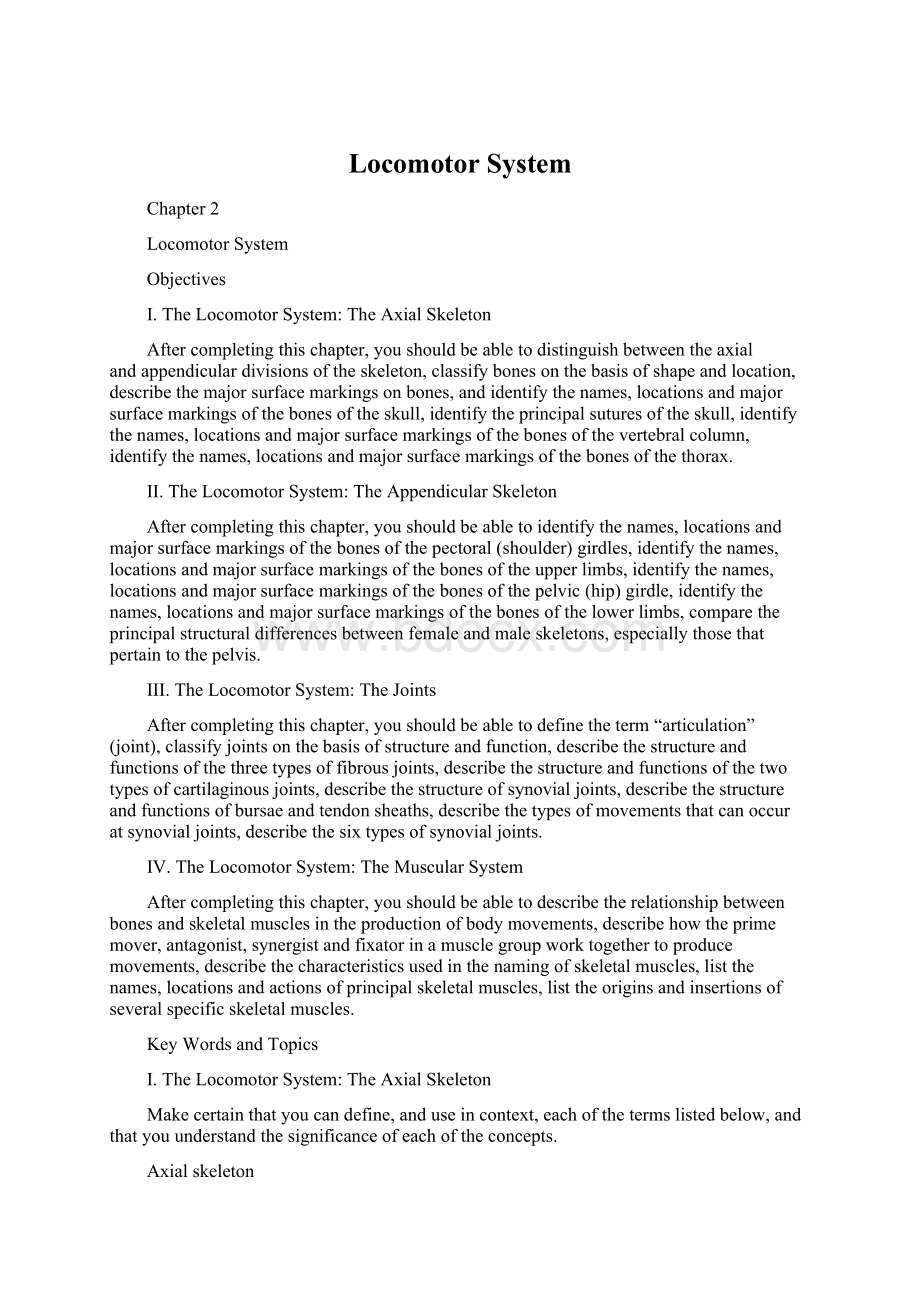Locomotor System.docx
《Locomotor System.docx》由会员分享,可在线阅读,更多相关《Locomotor System.docx(45页珍藏版)》请在冰豆网上搜索。

LocomotorSystem
Chapter2
Locomotor System
Objectives
I.The Locomotor System:
TheAxialSkeleton
Aftercompletingthischapter,youshouldbeabletodistinguishbetweentheaxialand appendicular divisionsoftheskeleton,classifybonesonthebasisofshapeandlocation,describethemajorsurfacemarkingsonbones,andidentifythenames,locationsandmajorsurfacemarkingsofthebonesoftheskull,identifytheprincipalsuturesoftheskull,identifythenames,locationsandmajorsurfacemarkingsofthebonesofthevertebralcolumn,identifythenames,locationsandmajorsurfacemarkingsofthebonesofthethorax.
II.The Locomotor System:
The Appendicular Skeleton
Aftercompletingthischapter,youshouldbeabletoidentifythenames,locationsandmajorsurfacemarkingsofthebonesofthepectoral(shoulder)girdles,identifythenames,locationsandmajorsurfacemarkingsofthebonesoftheupperlimbs,identifythenames,locationsandmajorsurfacemarkingsofthebonesofthepelvic(hip)girdle,identifythenames,locationsandmajorsurfacemarkingsofthebonesofthelowerlimbs,comparetheprincipalstructuraldifferencesbetweenfemaleandmaleskeletons,especiallythosethatpertaintothepelvis.
III.The Locomotor System:
TheJoints
Aftercompletingthischapter,youshouldbeabletodefinetheterm“articulation”(joint),classifyjointsonthebasisofstructureandfunction,describethestructureandfunctionsofthethreetypesoffibrousjoints,describethestructureandfunctionsofthetwotypesofcartilaginousjoints,describethestructureof synovial joints,describethestructureandfunctionsof bursae andtendonsheaths,describethetypesofmovementsthatcanoccurat synovial joints,describethesixtypesof synovial joints.
IV.The Locomotor System:
TheMuscularSystem
Aftercompletingthischapter,youshouldbeabletodescribetherelationshipbetweenbonesandskeletalmusclesintheproductionofbodymovements,describehowtheprimemover,antagonist,synergistand fixator inamusclegroupworktogethertoproducemovements,describethecharacteristicsusedinthenamingofskeletalmuscles,listthenames,locationsandactionsofprincipalskeletalmuscles,listtheoriginsandinsertionsofseveralspecificskeletalmuscles.
KeyWordsandTopics
I.The Locomotor System:
TheAxialSkeleton
Makecertainthatyoucandefine,anduseincontext,eachofthetermslistedbelow,andthatyouunderstandthesignificanceofeachoftheconcepts.
Axialskeleton
Appendicular skeleton
Typesofbones:
longbone,shortbone,flatbone,irregularbone, sesamoid bone. Bonesurfacemarkings:
Note:
Youareresponsibleonlyforthespecificsurfacemarkingsthatappearwithinthelistbelow.UsethevolumetitledBriefAtlasoftheSkeleton,SurfaceAnatomy,andSelectedMedicalImages,whichaccompaniesthetextbook,tohelpyouasyoustudytheindividualbones.
A. Skull
a. cranialbones:
1. frontalbone:
supraorbital margin
2. parietalbones
(2)
3. temporalbones
(2):
zygomatic arch,externalauditory meatus,mastoidprocess,internalauditory meatus.
4. occipitalbone:
foramenmagnum,occipital condyles.
5. sphenoidbone:
opticforamen
6. ethmoid bone:
superiorandmiddlenasal conchae (turbinates;singularis concha)
b. facialbones
1. nasalbones
(2)
2. maxillae(2;singularismaxilla):
alveolarprocess.
3. zygomatic bones
(2)
4. lacrimal bones
(2):
lacrimal fossa.
5. palatinebones
(2)
6. inferiornasal conchae or turbinates
(2)
7. vomer
8. mandible:
body, rami (2;singularis ramus),angles
(2), coronoid processes
(2), condylar processes
(2), temporomandibular joints
(2),alveolarprocess
c. orbits
(2)
d. suture:
coronalsuture,sagittalsuture,lambdoidsuture
e. paranasal sinus
f. fontanels
g. nasalseptum
h. hyoidbone
B. vertebralcolumnorspineorbackbone
a. vertebra(pluralisvertebrae)
b. intervertebral disc
c. normalcurvesofthespine
d. partsofatypicalvertebra:
body,vertebralarch,vertebral(spinal)cavity, intervertebral foramen, spinous process,transverseprocesses,superior articular processes,inferior articular processes.
e. regionsofthevertebralcolumn
I. cervicalvertebrae(7;C1-C7)
i.atlas(C1)
ii.axis(C2):
densor odontoid process.
II. thoracicvertebrae(12;T1-T12)
III.lumbarvertebrae(5;L1-L5)
IV.sacrum:
anteriorsacralforamina,mediansacralcrest,posteriorsacralforamina,sacralcanal,sacroiliacjoint.
V.coccyx
C. thorax
a. sternumorbreastbone
I. manubrium:
suprasternal notch, clavicular notches
II. body:
sternal angle
III.xiphoid process
D. ribs(12pairs)
a. costalcartilage
b. trueribs(1-7)
c. falseribs(8-12):
floatingribs(11-12)
II.The Locomotor System:
The Appendicular Skeleton
Makecertainthatyoucandefine,anduseincontext,eachofthetermslistedbelow,andthatyouunderstandthesignificanceofeachoftheconcepts.
Pectoralgirdlesorshouldergirdles
(2)
A.clavicleorcollarbone:
sternal end, acromial end
B.scapulaorshoulderblade:
spine, acromion, glenoid cavity,superior,lateral(axillary)andmedial(vertebral)borders,superiorandinferiorangles, coracoid process, supraspinous fossa, infraspinousfossa, subscapular fossa,
Upperlimbsorupperextremities
(2)
A. humerus:
head, glenohumeral joint,anatomicalneck,greatertubercle,lessertubercle, intertubercular sulcus,surgicalneck,bodyorshaft,deltoid tuberosity, capitulum,radial fossa, trochlea, coronoidfossa, olecranon fossa,medial epicondyle,lateral epicondyle
B.ulna:
olecranon, coronoid process, trochlear notch,head, styloid process
C.radius:
head,radial tuberosity, styloid process, radiocarpal jointorwristjoint
D.carpalbones[Note:
Youareexpectedtolearnthenamesofthecarpals,butnottheirprecisepositions.]:
scaphoid, lunate, triquetrum, pisiform,trapezium,trapezoid, capitate, hamate.
E.metacarpalbones(intheanatomicalposition,thefirstmetacarpalisthelateralbone):
head
F.phalanges:
proximal,middle(exceptinthumb)anddistalphalanges,pollex
Pelvicgirdleorhipgirdle
A. coxal boneorhipbone(or os coxa):
pubic symphysis,bonypelvis
B.ilium:
acetabulum,iliaccrest,anteriorsuperioriliacspine,anteriorinferioriliacspine,posteriorsuperioriliacspine,posteriorinferioriliacspine,greatersciaticnotch,iliacfossa
B. ischium:
ischial spine,lessersciaticnotch, ischial tuberosity, obturator foramen.
C.pubis:
body,pubiccrest,hipor coxal joint
D.false(greater)pelvis
E.true(lesser)pelvis:
pelvicinlet,pelvicoutlet
F.comparisonoffemaleandmalepelvis
Lowerlimbsorlowerextremities
(2)
A.femurorthighbone:
head,neck,greater trochanter,lesser trochanter,bodyorshaft, linea aspera,medial condyle,lateral condyle,patellarsurface,medial epicondyle,lateral epicondyle.
B.patella
C.tibiaorshinbone:
lateral condyle,medial condyle, tibiofemoral joints, tibial tuberosity,medial malleolus
D.fibula:
head,lateral malleolus
E.tarsalbones:
talus, calcaneus, cuboid, navicular,1st(medial),2nd(intermediate)and3rd(lateral)cuneiforms.
F.metatarsalbones[Note:
The1stmetatarsalisthemedialbone.]
G.phalanges:
hallux
H.medialandlaterallongitudinalarches,transversearch
III.The Locomotor System:
TheJoints
Makecertainthatyoucandefine,anduseincontext,eachofthetermslistedbelow,andthatyouunderstandthesignificanceofeachoftheconcepts.
Articulationor arthrosis
A.structuralclassification:
fibrousjoints,cartilaginousjoints, synovial joints.
B.functionalclassification:
synarthrosis, amphiarthrosis, diarthrosis.
C.fibrousjoints:
suture, syndesmosis, gomphosis
D.cartilaginousjoints:
synchondrosis,symphysis
E.synovialjoints:
synovial(joint)cavity,articularcartilage,articularcapsule,fibrouscapsule,ligament,synovialmembrane,synovialfluid
F.bursa(pluralis bursae)
G.tendonsheaths
H.typesofmovementsat synovial joints:
gliding,flexion,extension,lateralflexion,hyperextension,abduction,adduction, circumduction,rotation,medial(orinternal)rotation,lateral(orexternal)rotation,inversion, eversion, dorsiflexion,plantarflexion, supination, pronation,opposition.
I. typesof synovial joints:
planarjoint,hingejoint,pivotjoint, condyloid orellipsoidaljoint,saddlejoint,ball-and-socketjoint
Kneejoint:
medialandlateral tibiofemoral joints, patellofemoral joint, tibial collateralligament,fibularcollateralligament,anterior cruciate ligament(ACL),posterior cruciate ligament(PCL),medialmeniscus,lateralmeniscus.
IV.The Locomotor System:
TheMuscularSystem
Makecertainthatyoucandefine,anduseincontext,eachofthetermslistedbelow,andthatyouunderstandthesignificanceofeachoftheconcepts.
Origin,Insertion,Belly,Leversystemandleverage,Primemoveroragonist,Antagonist,Synergist, Fixator.
Characteristicsusedtonamemuscles
Note:
Foreachofthefollowingmuscles,learnthename,location(e.g.,anteriorthigh)andaction;formusclesmarkedwithanasterisk,learntheoriginandinsertionaswell.
Occipitofrontalis:
frontalbellyandoccipitalbelly, orbicularis oris, zygomaticus major, buccinator, orbicularis oculi,*masseter,*temporalis,*sternocleidomastoid,*rectus abdominis,externaloblique,internaloblique, transversus abdominis,diaphragm,external intercostal,internalintercostals,*trapezius,*levator scapulae,rhomboidmajor,*pectoralis major, latissimus dorsi,*deltoid, subscapularis,*supraspinatus, infraspinatus, teres major, teres minor,*biceps brachii, brachialis, brachioradialus,*triceps brachii, pronator teres,